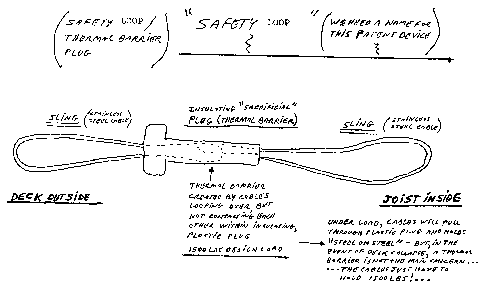Une partie des informations de ce site Web a été fournie par des sources externes. Le gouvernement du Canada n'assume aucune responsabilité concernant la précision, l'actualité ou la fiabilité des informations fournies par les sources externes. Les utilisateurs qui désirent employer cette information devraient consulter directement la source des informations. Le contenu fourni par les sources externes n'est pas assujetti aux exigences sur les langues officielles, la protection des renseignements personnels et l'accessibilité.
L'apparition de différences dans le texte et l'image des Revendications et de l'Abrégé dépend du moment auquel le document est publié. Les textes des Revendications et de l'Abrégé sont affichés :
| (12) Demande de brevet: | (11) CA 2714848 |
|---|---|
| (54) Titre français: | CONNECTEUR DE CHARGE LATERALE POUR TERRASSE A BATIMENT |
| (54) Titre anglais: | DECK-TO-BUILDING LATERAL-LOAD CONNECTOR |
| Statut: | Réputée abandonnée et au-delà du délai pour le rétablissement - en attente de la réponse à l’avis de communication rejetée |
| (51) Classification internationale des brevets (CIB): |
|
|---|---|
| (72) Inventeurs : |
|
| (73) Titulaires : |
|
| (71) Demandeurs : |
|
| (74) Agent: | GOWLING WLG (CANADA) LLP |
| (74) Co-agent: | |
| (45) Délivré: | |
| (22) Date de dépôt: | 2010-09-16 |
| (41) Mise à la disponibilité du public: | 2012-03-16 |
| Licence disponible: | S.O. |
| Cédé au domaine public: | S.O. |
| (25) Langue des documents déposés: | Anglais |
| Traité de coopération en matière de brevets (PCT): | Non |
|---|
| (30) Données de priorité de la demande: | S.O. |
|---|
A device for connecting an exterior deck structure to a contiguous building
has a pair
of interlocked cables, with a plastic plug encapsulating the interlocked ends
of the
cables and separating the cables to act as a thermal barrier. An expanded head
at one
end of the plug, with associated foam washer seals against a deck header,
while the
exterior cable end of the device is connected to a deck joist and the interior
end of the
cable device is connected to a building joist, wherein the joists may be
laterally offset.
Note : Les revendications sont présentées dans la langue officielle dans laquelle elles ont été soumises.
Note : Les descriptions sont présentées dans la langue officielle dans laquelle elles ont été soumises.

2024-08-01 : Dans le cadre de la transition vers les Brevets de nouvelle génération (BNG), la base de données sur les brevets canadiens (BDBC) contient désormais un Historique d'événement plus détaillé, qui reproduit le Journal des événements de notre nouvelle solution interne.
Veuillez noter que les événements débutant par « Inactive : » se réfèrent à des événements qui ne sont plus utilisés dans notre nouvelle solution interne.
Pour une meilleure compréhension de l'état de la demande ou brevet qui figure sur cette page, la rubrique Mise en garde , et les descriptions de Brevet , Historique d'événement , Taxes périodiques et Historique des paiements devraient être consultées.
| Description | Date |
|---|---|
| Le délai pour l'annulation est expiré | 2013-09-17 |
| Demande non rétablie avant l'échéance | 2013-09-17 |
| Inactive : CIB attribuée | 2012-11-30 |
| Inactive : CIB attribuée | 2012-11-30 |
| Inactive : CIB attribuée | 2012-11-30 |
| Inactive : CIB attribuée | 2012-11-30 |
| Réputée abandonnée - omission de répondre à un avis sur les taxes pour le maintien en état | 2012-09-17 |
| Demande publiée (accessible au public) | 2012-03-16 |
| Inactive : Page couverture publiée | 2012-03-15 |
| Inactive : CIB attribuée | 2010-10-27 |
| Inactive : CIB attribuée | 2010-10-27 |
| Inactive : CIB attribuée | 2010-10-21 |
| Inactive : CIB en 1re position | 2010-10-21 |
| Inactive : Certificat de dépôt - Sans RE (Anglais) | 2010-10-05 |
| Lettre envoyée | 2010-10-05 |
| Demande reçue - nationale ordinaire | 2010-10-05 |
| Date d'abandonnement | Raison | Date de rétablissement |
|---|---|---|
| 2012-09-17 |
| Type de taxes | Anniversaire | Échéance | Date payée |
|---|---|---|---|
| Taxe pour le dépôt - générale | 2010-09-16 | ||
| Enregistrement d'un document | 2010-09-16 |
Les titulaires actuels et antérieures au dossier sont affichés en ordre alphabétique.
| Titulaires actuels au dossier |
|---|
| ULI WALTHER |
| GERDA WALTHER |
| MIRCO WALTHER |
| Titulaires antérieures au dossier |
|---|
| BERND WALTHER |